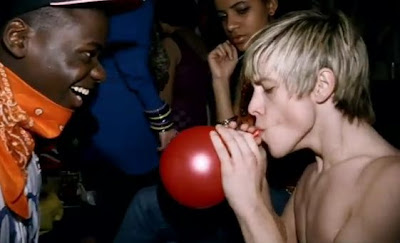 The Skins promo trailer shows young people in many different ways. The promo begins with someone in a bear suit bouncing on a bed. There are lots of different things happening in the promo, such as drug taking, drinking, partial nudity, and sexual promiscuity and the use of many quick cuts between clips keeps it fast-paced and exciting. The soundtrack is The Gossip - Standing in the way of Control. This fits in well with the fast paced nature of the clip. The only sound in the promo is the non digetic soundtrack from The Gossip. This has the effect of making the viewer feel like they are not actually there which fosters a sense of voyeuristic fantasy.
The Skins promo trailer shows young people in many different ways. The promo begins with someone in a bear suit bouncing on a bed. There are lots of different things happening in the promo, such as drug taking, drinking, partial nudity, and sexual promiscuity and the use of many quick cuts between clips keeps it fast-paced and exciting. The soundtrack is The Gossip - Standing in the way of Control. This fits in well with the fast paced nature of the clip. The only sound in the promo is the non digetic soundtrack from The Gossip. This has the effect of making the viewer feel like they are not actually there which fosters a sense of voyeuristic fantasy.
 The first half of the clip shows young people as very
The first half of the clip shows young people as very 
 happy and enjoying themselves. They are dancing around the house, playing with toys, getting off with each other and taking various drugs. This represents youngsters as quite hyper and happy because of all dancing and running around you can see. It shows teenagers as being very promiscuous as nearly every other shot includes teenagers removing clothes, dancing sexually or making-out.
happy and enjoying themselves. They are dancing around the house, playing with toys, getting off with each other and taking various drugs. This represents youngsters as quite hyper and happy because of all dancing and running around you can see. It shows teenagers as being very promiscuous as nearly every other shot includes teenagers removing clothes, dancing sexually or making-out. Up until 45 seconds or so into the trailer, everything is happy and everyone having fun, drug taking, dancing and laughing. However, the second half of the promo shows the characters arguing, breaking things, vommiting and generally making a mess of the place. It begins to show
Up until 45 seconds or so into the trailer, everything is happy and everyone having fun, drug taking, dancing and laughing. However, the second half of the promo shows the characters arguing, breaking things, vommiting and generally making a mess of the place. It begins to show the nasty side of drug and alcohol use which balances out the video and shows that not everything at the party is still going well. People begin to start throwing up, pushing each other, breaking vases and other things... This shows the bad side of alcohol and drugs and represents the effects they have on teenagers. This represents teenagers as the kind of people who are easily affected by alcohol and become out of control while under the effects. This shows the different side to teenagers when they have been ingesting alcohol and drugs.
the nasty side of drug and alcohol use which balances out the video and shows that not everything at the party is still going well. People begin to start throwing up, pushing each other, breaking vases and other things... This shows the bad side of alcohol and drugs and represents the effects they have on teenagers. This represents teenagers as the kind of people who are easily affected by alcohol and become out of control while under the effects. This shows the different side to teenagers when they have been ingesting alcohol and drugs.The camera shots are mostly close ups and mid-shots. This is done so as to capture all the different characters and their reactions to the party. The main themes of the promo are sex, drugs, alcohol and then towards the end, violence, figting and arguments. The colours used are mostly bright, vivid colours. This, along with the use of bright flashing lights helps give a feeling of being high on drugs and at the party. This is also enhanced with the use of slow motion on some of the clips, distorting your perceptions of time - as if you are high.
Overall this promo represents young people as very promiscuous and fun-loving. It also represents teenagers as typically taking loads of drugs and drinking too much, then being sick everywhere and getting into fights as they are all drunk or high on various drugs. The music and editing in the promo shows young people as very energetic and upbeat as they are all dancing around having fun. From this promo, you would expect the whole series to be all about parties, sex and drugs.